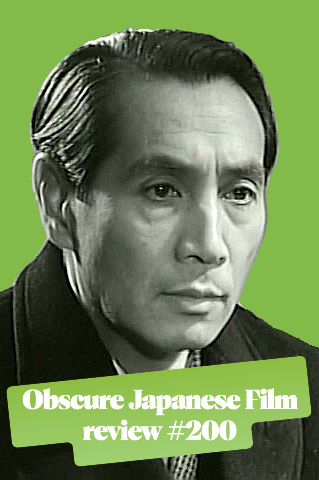Yuasa (Masayuki Mori) is a middle-aged painter in the process of divorcing his wife (Hisano Yamaoka) and in love with the much younger Tsuyuko (Mie Kitahara), who reciprocates his feelings. However, Tsuyuko’s father (Ichiro Sugai) is dead set against the match and packs her off to America in the hope that she’ll forget about Yuasa. While she’s gone, Yuasa decides he’d better accept the situation and gets married instead to another much younger woman, Tomoko (Keiko Amaji), but she just likes the idea of being married to a famous painter and continues to see her former student boyfriend, Kunihiko (Joe Shishido) on the sly. Then Tsuyuko returns from America…
This Nikkatsu production was based on a novel originally published as a serial between 1933 and 1935 by Chiyo Uno (female, 1897-1996). The character of Yuasa was based on the painter Seiji Togo (1897-1978), with whom Uno had an affair that lasted from 1930-34. The story must have seemed old-fashioned even in 1956, and it’s doubtful that the film was very successful commercially as Uno’s work was not adapted for the screen again until 1984. Nikkatsu is also a studio not known for its tragic love stories and would soon focus its attention on producing gangster movies aimed at the youth market.
The fact that the central character of Yuasa never really convinces or comes to life leaves this film dead in the water. The other characters are constantly making a fuss about what an amazing artist he is, but we see no evidence of this except a not particularly impressive portrait of Tsuyuko dressed like Little Bo Peep. As we never see the beginning of their relationship, it’s impossible to understand how these two were drawn to each other in the first place. Worse still, it seems that we’re expected to sympathise with how hard life must be for Yuasa as a wealthy middle-aged younger-woman magnet who lives a life of idleness. When Tsuyuko’s father understandably prevents him from getting what he wants, Yuasa mopes his way through the remainder of the film wallowing in self-pity, Masayuki Mori rarely deviating from his patented Staring Into The Void expression.
The cast also includes Kinuyo Tanaka (wasted here as a friend of Yuasa’s) and a thin-faced Joe Shishido before the cheek job, but it’s the great Hisano Yamaoka who steals it here as the ex-wife who’s probably supposed to be a shrew, but for whom I felt quite sympathetic, though not quite as much as I did for Yuasa’s second wife Tomoko when she complains about being, ‘Bored, bored, bored!’
This is the first film I’ve seen by director Yutaka Abe (1895-1977), who had lived in America from around 1912-24 and worked in Hollywood, first as an extra and later as a featured actor. This experience led to him becoming a director after his return to Japan, and he directed his first film there in 1925. I can’t say that I was much impressed by his work in Confession, in which he lets the same scene between Mori and Shishido play out twice (first on a beach, then again immediately afterwards in a hotel room) and uses waves crashing against rocks as a visual metaphor for passion – something I’m pretty sure was a hoary old cliché even then.
Amazon Japan (no English subtitles)
Thanks to A.K.




















